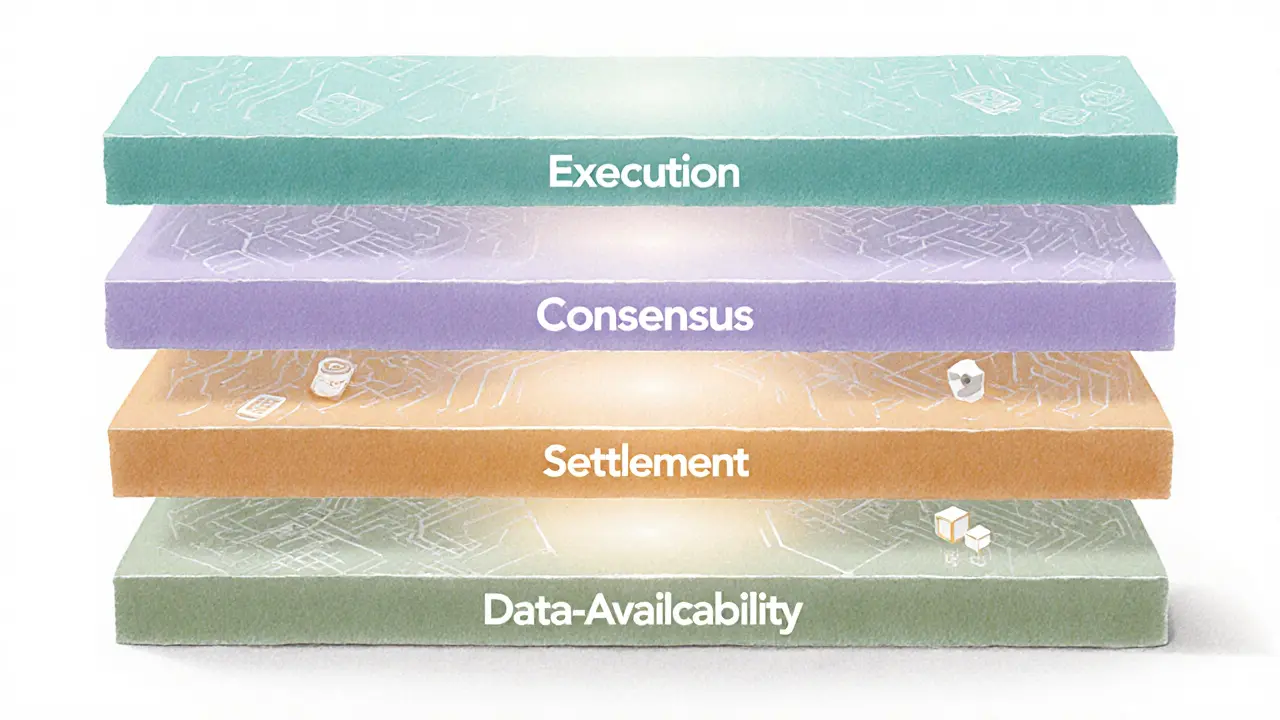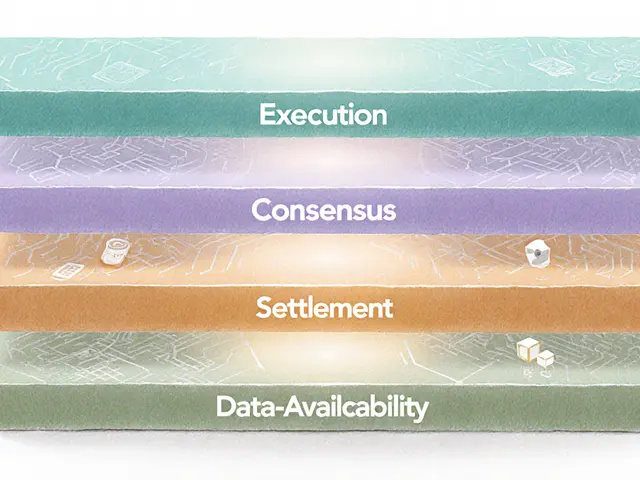Modular Blockchain Interoperability: How Cross-Chain Messaging Powers the Future

Modular Blockchain Interoperability Explorer
Execution Layer: Runs smart contracts or transaction logic.
Consensus Layer: Orders blocks and finalizes them.
Settlement Layer: Records final state changes and handles value transfer.
Data-Availability Layer: Makes raw block data accessible to anyone who needs it.
Cross-chain Messaging: Transfers verifiable data packets between networks.
Asset Portability: Lets tokens retain value and metadata when moving across chains.
Smart-contract Composability: Enables contracts to call each other across chains.
Shared Security: Ensures cross-chain calls inherit security guarantees of the source chain.
1-to-1 Interoperability
- Token bridge, simple transfers
- Low complexity
- Sub-second to few seconds latency
- Fee per transaction
- External custodial contracts
n-to-1 Interoperability
- Multi-chain DEX, aggregators
- High complexity
- Potentially higher latency
- Aggregated fees
- Shared security or coordinated validators
Polkadot uses a Relay Chain for consensus and shared security, with parachains handling execution and data availability. The XCM (Cross-Consensus Messaging) protocol enables secure communication between parachains.
Key benefits:
- Messages are secured by the Relay Chain’s validator set
- Eliminates need for external bridges
- Enables atomic operations across multiple chains
These projects simplify multi-chain interactions:
- Account Abstraction: Decouples user identity from individual chain accounts
- Wallet Abstraction: Unified interface for managing assets across multiple chains
- Orchestration Frameworks: Coordinate cross-chain transactions (e.g., Li.Fi, Klaster)
Goal: Provide a seamless user experience similar to single-chain apps.
Common risks with bridges:
- Compromised validator keys
- Buggy contract code
- Replay attacks
Modular interoperability helps reduce risk by:
- Keeping most logic on source chain
- Using shared security models
Which of the following is NOT a pillar of interoperability?
Every time you try to move a token from Ethereum to Solana, you end up juggling wallets, paying sky‑high fees, and hoping the bridge you chose isn’t the next headline‑grabber for a hack. What if the blockchain world behaved more like the internet-where a single click lets you hop from one site to another without a second thought? That seamless flow is exactly what modular blockchain interoperability aims to deliver by separating execution, consensus, settlement, and data‑availability into independent layers that can talk to each other safely and efficiently. This article breaks down the tech behind that vision, compares the current approaches, and shows where the industry is heading.
Key Takeaways
- Modular blockchains split core functions into layers, making it easier to connect disparate networks.
- Cross‑chain messaging, asset portability, smart‑contract composability, and shared security are the four pillars of interoperability.
- 1‑to‑1 solutions work for pair‑wise transfers, while n‑to‑1 frameworks aim to coordinate dozens of chains at once.
- Polkadot’s Relay Chain and its XCM protocol are the most mature example of built‑in modular interoperability.
- Orchestration projects (account abstraction, wallet abstraction, and cross‑chain frameworks) are turning complex multi‑chain actions into a single click.
What Makes a Blockchain "Modular"?
In a monolithic chain, execution, consensus, settlement, and data availability live under one roof. Bitcoin, for example, does everything in a single layer-every node validates transactions, reaches consensus, and stores the complete history. A modular blockchain pulls those responsibilities apart:
- Execution layer runs smart contracts or transaction logic.
- Consensus layer orders blocks and finalizes them.
- Settlement layer records final state changes and handles value transfer.
- Data‑availability layer makes raw block data accessible to anyone who needs it.
Because each layer can be upgraded or swapped independently, developers can stitch together the best‑of‑breed components. More importantly, these layers can be linked to equivalent layers on other networks, forming the backbone of interoperability.
Four Pillars of Interoperability
To make two modular blockchains talk, four technical building blocks must line up:
- Cross‑chain messaging transfers verifiable data packets between networks, ensuring the receiving chain can prove the message’s authenticity.
- Asset portability lets tokens retain their value and metadata when they move across chains, often via wrapped representations or native bridges.
- Smart‑contract composability enables a contract on Chain A to call functions on a contract on Chain B as if they lived on the same ledger.
- Shared security ensures that cross‑chain calls inherit the security guarantees of the source chain, preventing one weak network from dragging down the whole system.
When all four line up, developers can build applications that span dozens of ecosystems without the user noticing any hidden steps.
Interoperability Models: 1‑to‑1 vs n‑to‑1
Most bridge projects you hear about today fit the 1‑to‑1 model. They connect two specific chains, translate messages, and stop there. This works for simple token swaps but quickly falls apart when an application needs real‑time data from many chains-think a global DEX that must price assets based on liquidity across all rollups.
| Aspect | 1‑to‑1 Interoperability | n‑to‑1 Interoperability |
|---|---|---|
| Typical Use‑Case | Token bridge, simple cross‑chain transfers | Multi‑chain DEX, cross‑chain DeFi aggregators |
| Complexity | Low - single pair of protocols | High - must track state across many chains |
| Latency | Generally sub‑second to few seconds | Potentially higher due to multiple confirmations |
| Cost | Fee per bridge transaction | Aggregated fees; may need batching solutions |
| Security Model | Often relies on external custodial contracts | Requires shared security or coordinated validator sets |
Because n‑to‑1 scenarios demand simultaneous access to many contract states, developers are turning to orchestration frameworks that can batch calls, cache interim results, and settle everything in a single atomic step.

Polkadot and XCM: A Live Example of Modular Interoperability
Polkadot, conceived by Dr. Gavin Wood, was the first blockchain built around modularity. Its architecture consists of a central Relay Chain which handles consensus and shared security for all attached parachains. Each parachain (or rollup) focuses on execution and data availability, allowing them to specialize-one might be optimized for privacy, another for high‑frequency trading.
The magic happens through the XCM (Cross‑Consensus Messaging) protocol that lets any parachain send verified messages to any other parachain or the Relay Chain itself. XCM eliminates the need for external bridges because messages travel on‑chain, are secured by the Relay Chain’s validator set, and can carry both data payloads and asset transfer instructions.
Because every parachain inherits the Relay Chain’s security, an application can safely query price data from ten different parachains, compute a cross‑chain arbitrage, and settle the trade-all under a single finality guarantee. That’s the essence of n‑to‑1 interoperability in practice.
Orchestration: Making Multi‑Chain Actions Click‑Ready
Even with XCM, users would still need to click multiple times, sign separate transactions, and monitor several wallets. Orchestration projects abstract that complexity away:
- Account abstraction decouples the user’s identity from any single chain’s account model. Projects like Avocado let you sign a single intent that is then translated into the appropriate calls on each target chain.
- Wallet abstraction offers a unified interface to manage assets across Ethereum, Solana, Near, and dozens more. OneBalance, Particle Network, and Arcana Network are leading examples that let you see a single portfolio balance regardless of where the tokens live.
- Orchestration frameworks coordinate the actual cross‑chain transaction flow. Li.Fi and Klaster provide SDKs that batch messages, handle retries, and ensure atomic settlement across n‑to‑1 scenarios.
When you combine these three layers, the user experience mirrors a single‑chain app: you click “Swap”, sign once, and the backend handles all the moving parts.
Security Realities: Lessons from Bridge Hacks
Cross‑chain bridges have been prime targets. The $600million Ronin bridge hack in 2022 showed that a single compromised validator set can empty a whole ecosystem. Other incidents-like the Wormhole and Nomad hacks-reinforced the same lesson: complexity breeds risk.
Modular interoperability reduces attack surface in two ways:
- By keeping most logic on the source chain, you avoid storing large amounts of value in a separate bridge contract.
- Shared security models (e.g., Polkadot’s Relay Chain) pool validation power, making it harder for an attacker to gain a majority on any single parachain.
Nevertheless, developers must still audit message‑verification code, use multi‑sig governance for critical updates, and monitor latency spikes that could indicate replay attacks.
Future Outlook: From Chain Abstraction to Full‑Scale n‑to‑1
The next wave of modular interoperability will likely center on “chain abstraction” layers-software stacks that present every blockchain as a generic endpoint with a common API. When an app calls "transfer(token, amount, destination)", the abstraction layer picks the optimal route, handles gas‑payment conversion, and returns a single receipt.
Key trends to watch:
- Layer‑0 networks expanding beyond Polkadot-e.g., Cosmos with IBC, and emerging Layer‑0s that promise sub‑second finality across hundreds of chains.
- Zero‑knowledge proofs that can certify state across chains without revealing data, boosting privacy for cross‑chain DeFi.
- Dynamic validator sets that allow a parachain to borrow security from multiple parent chains, creating hybrid shared‑security models.
With modular adoption up 300% in the past year, the momentum is clear. The real test will be whether these solutions can keep fees low, latency under a second, and security as rock‑solid as the best single‑chain networks. If they succeed, the blockchain ecosystem will finally behave like the open internet: truly interoperable, frictionless, and ready for mainstream use.
Frequently Asked Questions
What exactly is a modular blockchain?
A modular blockchain separates execution, consensus, settlement, and data‑availability into distinct layers that can be upgraded or swapped independently, allowing each layer to specialize and interact with equivalent layers on other networks.
How does cross‑chain messaging differ from a traditional bridge?
Traditional bridges often lock assets on one chain and mint a wrapped version on another, requiring separate contracts and trust assumptions. Cross‑chain messaging passes verified data packets directly between chains, letting each side enforce its own security rules without holding user funds.
Why is n‑to‑1 interoperability harder than 1‑to‑1?
n‑to‑1 requires aggregating state from many chains in a single atomic operation. This adds latency, higher gas costs, and complex validation because every participating chain must prove its view of the data before the transaction can finalize.
Can I use Polkadot’s XCM without being a validator?
Yes. Most developers interact with XCM through SDKs or relay‑chain‑provided APIs. Validators are only needed if you want to run a parachain or contribute to the Relay Chain’s security set.
What are the biggest security risks with current bridges?
Risks include compromised validator keys, buggy contract code that lets attackers mint unlimited wrapped tokens, and replay attacks where a message is processed twice on a destination chain. Regular audits and shared‑security models help mitigate these threats.







I love how the article breaks down modular layers – it really demystifies the architecture. 😊 The examples make the concepts feel tangible, especially the Polkadot XCM part. It’s great to see both security and usability tackled together. Looking forward to more real‑world deployments!
The exposition leverages a layered abstraction paradigm, thereby encapsulating consensus semantics within a discrete substrate. Nonetheless, the narrative adopts a rather passive tone, eschewing direct imperative recommendations. Overall, the technical lexicon remains consistent.
Keeping things simple makes adoption far easier.
Exactly, brevity drives developer onboarding; a concise bridge spec reduces friction dramatically. The community should prioritize minimalism in protocol design.
The security section nailed the common pitfalls, especially the reminder about validator key exposure. I appreciate the emphasis on audit frequency and multi‑sig governance. It’s also encouraging to see shared security models highlighted as a mitigation strategy. This balanced view helps developers weigh trade‑offs effectively.
While the security advice is commendable, it borders on the overly cautious stance that stalls innovation. One must question whether perpetual audits are a practical necessity in fast‑moving ecosystems. Nevertheless, the formal tone underscores the gravity of bridge vulnerabilities.
Whoa, this is exactly the kind of optimism we need! If we can abstract away wallet chaos, users will finally have a seamless experience. Let’s keep pushing those orchestration frameworks forward.
Absolutely, the user‑centric abstraction aligns with broader UX goals across chains. A unified interface could be a game‑changer.
Cross‑chain messaging truly represents the connective tissue of the decentralized internet.
When a message is verifiably anchored on the source chain, the destination can trust its authenticity without custodial intermediaries.
This eliminates the need for locked collateral, which has been the Achilles' heel of many legacy bridges.
Moreover, the protocol‑level guarantees allow developers to build composable smart contracts that call across ecosystems as naturally as local functions.
From a performance perspective, the latency improvements reported in recent XCM testnets are astonishing, dropping from seconds to sub‑second finality in many cases.
Such gains are largely attributable to the shared validator set of the relay chain, which reduces the consensus overhead on each parachain.
Security analysts have noted that consolidating validator responsibility mitigates the attack surface, as attackers must compromise a broader set of participants.
Nevertheless, the system is not immune to replay attacks; proper nonce handling remains essential.
Developers should also be mindful of the gas cost differentials when routing messages through multiple layers, as these can accrue quickly.
Orchestration frameworks like Li.Fi are already offering fee‑aggregation mechanisms to address this concern.
From a user experience standpoint, the emergence of account abstraction means a single signature can approve complex multi‑chain operations.
That single click paradigm is exactly what mainstream adoption needs to feel safe and intuitive.
Furthermore, zero‑knowledge proofs are beginning to enable privacy‑preserving cross‑chain state verification, opening doors for confidential DeFi.
The modular approach also encourages specialization; a data‑availability layer can be optimized for throughput while the settlement layer focuses on finality.
Overall, the ecosystem is moving toward a layered stack where each component can evolve independently yet remain interoperable.
If this trajectory continues, we might soon see a truly unified blockchain fabric where users never notice the underlying chain boundaries. 🚀
The bridge is still a fragile point.
The architectural delineation of execution and consensus layers is a foundational principle that cannot be overstated. By abstracting these concerns, designers achieve both scalability and modular upgrade paths. Ignoring this paradigm would result in monolithic stagnation.
Your summary captures the essence perfectly; keep sharing these insights with the community.
Imagine a world where a single transaction ripples across ten ecosystems, settling atomically in a heartbeat-this is not science fiction but an imminent reality. The narrative paints a vivid picture of such possibilities, stirring both awe and urgency. It's a call to arms for developers to embrace orchestration frameworks. The emotional weight of bridging the gap between isolated chains resonates deeply. As we stand on this precipice, the stakes have never been higher. Let’s channel that energy into building robust, user‑friendly bridges.
From a cryptographic standpoint, nonce management and replay protection are paramount. The message verification logic must be deterministic across all participating layers. Adhering to these standards ensures consistency and security.
Modular design improves upgradeability. Shared security reduces risk.
Most of these papers gloss over the real costs. They’re nothing but hype.
I find the enthusiasm for modularity misplaced; the complexity it introduces outweighs the benefits. Centralized solutions remain far more efficient. The community should focus on proven models rather than chasing every new buzzword.
Fair point, but there are trade‑offs to consider. Everybody moves at their own pace.
The quest for seamless interoperability mirrors humanity’s age‑old desire to transcend borders, both virtual and tangible. In every layer we peel back, we discover a new frontier of collective potential. It’s a poetic dance of code and trust.
When I contemplate the sprawling tapestry of blockchains, each strand glittering with its own set of promises, I cannot help but marvel at the audacity of architects who dare to stitch them together. The very notion of a universal messaging protocol evokes images of bustling interstellar highways where data packets zip by like luminous fireflies, each carrying the weight of value and intention. Yet, beneath this dazzling veneer lies a labyrinth of governance, security, and economic incentives that must be meticulously choreographed. It is precisely this delicate ballet of consensus and execution that determines whether we ascend to a new era of digital unity or tumble into fragmented chaos. Consequently, every developer, investor, and enthusiast bears a responsibility to advocate for robust standards, transparent audits, and inclusive design philosophies. In short, the future of cross‑chain harmony depends not on isolated brilliance but on collaborative symphonies that echo across the entire ecosystem.
Modular hype is overblown; simplicity beats complexity every time.